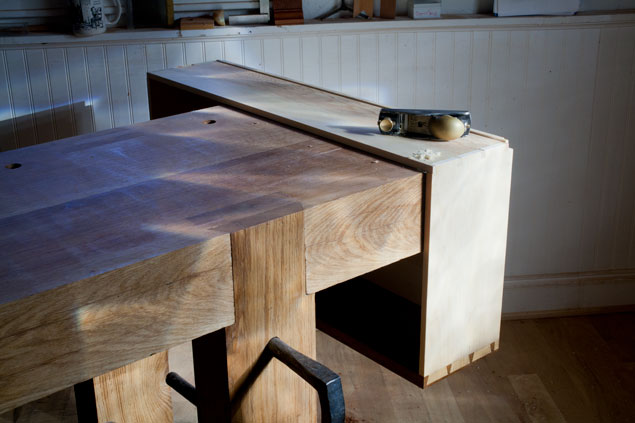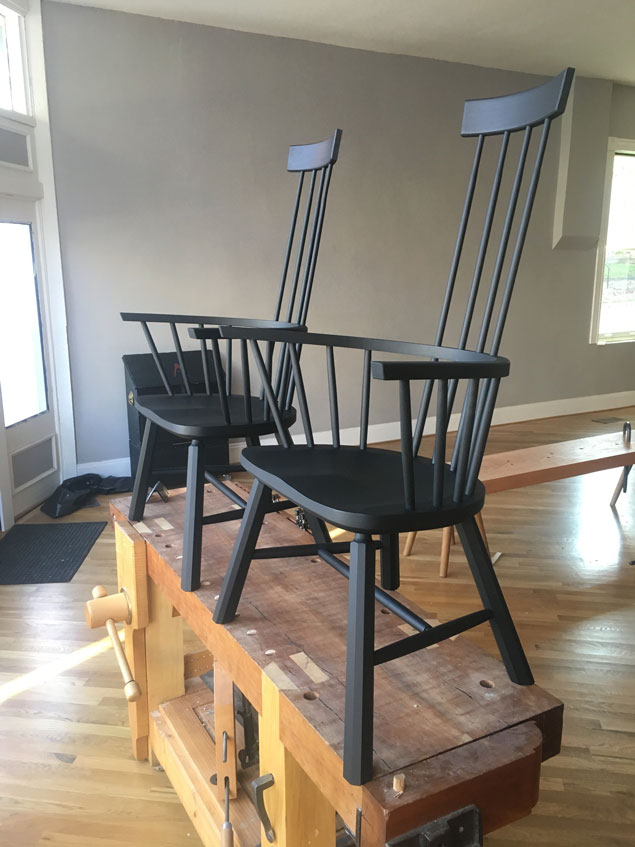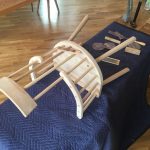We may receive a commission when you use our affiliate links. However, this does not impact our recommendations.
Perhaps it’s the American love for excess. But no matter how many examples I cite or pleas I make, most beginning woodworkers seek to build workbenches that are entirely too wide.
Most historical workbenches are 18” to 22” wide – and they are that wide for functional reasons that I’ll explain in a minute. And yet, sawyers I know who cut slabs for benches are regularly asked for 32”-wide slabs (or wider). In my travels I regularly encounter benches that are 48” wide.
So I’ll try to explain the historic rationale again.
Let’s say you decide to build your own automobile from scratch. And you decide to make it 11’ wide so three people can sit in the front row instead of two. I think you can see the problem with your plan. The car won’t fit into the standard-sized lanes on the road. You won’t be able to enter a parking garage. Good luck going through the drive-through to get a burger or even getting into some gas stations.
Workbenches are like that. The historical width matches the standard sizes of casework, chairs and component parts to make it easy to work on them.
Let’s say you dovetail a carcase and need to level the joints with a plane or sander. If your bench is narrow you can simply sleeve the carcase over your benchtop and do the work without any fussy work-arounds. If your bench is too wide for this, you’re going to have to jig up something awkward. Drawers for dressers work the same way – they sleeve over the benchtop so you can plane them up.
Chairs are another good example. When I post photos of my chairs that I’m working on the blog, I usually get a comment that says something like: “Wow, your benchtop exactly matches the depth of your chairs. Did you plan it that way?”
Again, the traditional width of the workbench is at work. With a narrow bench you can place a chair at the end of your bench and work all around it. You can clamp it easily to the benchtop from a variety of angles.
Another advantage of narrow benches: Your tools won’t roll out of your reach.
I am sure there are some specialty applications where an over-wide workbench is an asset, but I have yet to encounter that situation in my work.
— Christopher Schwarz
Here are some supplies and tools we find essential in our everyday work around the shop. We may receive a commission from sales referred by our links; however, we have carefully selected these products for their usefulness and quality.











Our French friend AJR tells us 21-26 (US rounded inches), per your posted translation.
The first bench I built was 30″ deep. I hated it. I couldn’t reach the tools hung on the wall behind it, and I was glad to leave it behind when I moved a few months later.
My current bench is about 24″ deep. I like it, but after keeping track of it for a couple of years, the usage pattern is:
– Front 12″: used on every project.
– Next 6″: used on most projects.
– Back 4″: used to store tools.
My next bench will be 20″ deep, and will (I hope) stand away from the wall.
Chris,
Are we are the only woodworkers who share a bench? Our Seniors Society in Vancouver, Canada has a workshop with three shared benches. We have 105 woodworkers over 55 who can use the shop. Our new workbench regularly has 5 people working at it; it measures 38″ x 84″. It is a split top roubo and the design was recommended to us by folks at Sawmill Creek. We relied heavily on your Workbench Design book. This workshop for seniors is the best idea ever! A splinter group of 22 members makes items to sell at the bi-annual fairs to raise funds for the Society. This means that we never run out of projects to make. We’re productive; we enjoy the comaraderie and we are learning new woodworking skills all the time. This large workbench works well for us.
Workbench photo link: https://goo.gl/photos/qxqb1iuqs4bZLhvt9
As with all things in life…no one size fits all. Different strokes for different folks. My bench is 6′ long and 26″ wide. I like the width…wouldn’t mind a couple of inches wider but I would not include a
tool reservoir. It was originally 32″ tall but I put another top on it to make it 35″ which I like much better even though I am not very tall.
It just so happened that when I was going to build my new workbench, that your book came out on workbench design. I changed my design to 21″ instead of 3′ and ditched the “table style” overhang to front and rear edges that were flush with the legs. I also added a sliding deadman and found an $18 leg vise at a flea market. This is such a better workbench then I was originally going to make and it has made me a better woodworker. Thanks for all of the advise and guidance.
Well, yes, but . . . If you’re only using the workbench for building furniture, sure. I’d suspect that most of us use it for many other things too, and a slightly wider bench is very useful for fixing the lawnmower or the snowblower or any of the other innumerable tasks somebody who isn’t a professional woodworker uses their bench for. No space for two. But 48″ is just silly, I agree. FWIW I just measured – 24″ x 74″ top, 37″ high; I’m 6′-2″. Works fine. I very occasionally wish it were a little wider, but never for woodworking.
Chris, I agree on the width but no longer on height. I constructed my bench based off of your 18th century bench DVD. Mine ended up 61″x21″x5″. My bench is 32.5 inches tall. I am 5’10”.
I have tried as you requested in your book, but I just can’t get comfortable at that height. I use a 5″ tall Moxon vise with a bench on a bench attachment. I find this a much more comfortable height for sawing and chisel work. For hand planing even the 32.5″ seems a bit low.
I think I am going to add a three inch riser to the legs with the hope that it is a good fit for both hand plane work and other hand tool work.
I agree with the author having built a bench to suit a small space. If it weren’t for that space limitation in my old shop I may have been tempted to build a Roubo-style bench that was wider. It ended up around 21″ and I’ve never had a problem. In fact, I’ve benefited from all the reasons for a narrow bench in this article. The regret I do have is the length. Again, limited by space in my previous workshop, it’s about 5 1/2″ feet long and while it’s better than nothing, my next slab Roubo will be about 22-24″ and about 8′-10′ in length.
Basically agree…but sometimes you might need some extra width…so would it be an idea to have a good solid extension as more of a standard in these workbenches?
But but but… where else but on my 36″ x 72″ workbench can I stack my pile of designs and plans for the 4 projects I’ll probably never finish but have some of the work and wood stacked neatly in piles, the various grades of sandpaper from the last time I used my random orbit sander (holding one end of the work with my hand as I sand it on my tablesaw top); not to mention the various magazines, catalogues and renew requests from woodworking magazines, the one-handed bar clamps on the edge of the bench, the 4 sheets of veneer I’m trying to soften for one of the above named projects and the glue, masking tape and rubber bands for the 11 sets of 5″ Polygon shaped boxes I’m making? Huh? huh? Didn’t think of that, did you?
Chris I like and have used your exact measurements for work tables before but I know use a 4 table work area, I will explain , each work table is 16″ w + 40″ L and all are interlock able so if I need something wider or something longer I add a table as needed, also for this combination I have two slides for two tables 8″ w + 40″ L this gives my additional options all table are on locking rollers. My table saw has 3 tables the same height as my table saw 24″ + 36″ , the same 3table are used with my miter saw. All table are also cabinets.. Well just something else to think about.. I have used this tables combo for over 35yrs. And people that have seen them, built and use the same the same.. Well happy building..
Over the years I’ve discovered that having two work benches, one the size that Chris recommends and one that is larger works well for me. Sure, the chairs fit on the work bench as shown but if you turn the chair just a little bit, it will fall off the bench. Most of the drawers I make will not go over the end of the narrower bench so that would not be much of a selling point. I spend a lot of time moving tools around or removing them from the narrow bench to prevent them from falling on the floor while working on a piece. With the larger bench this is not an issue. My large bench has dog holes and two vises so it is a bench as opposed to an assembly table. I have incorporated the large bench to be the out feed table of my table saw as well. I really like my narrow bench and as Chris notes in his observation, I did have a large bench as my first. I would not want to do without either one but after using both for a number years, if person has room for one bench only, in most cases I would recommend the wider bench for more versatility. Chris, I just want to say, I would not be able to work wood as well as I do if you hadn’t put forth all effort you do to inform your fellow woodworkers. I really appreciate your efforts!
I’ve built two benches, both using Chris’ workbench books (one’s even signed – lucky me). One 24″ wide and the other 22″. I’ve never had a situation where I wished they were wider. But, it helps to have a very large cabinet saw with several extensions and a separate work table.
Mine is 32″ wide and has been just right for 15 years. I do wish I had made it 2 or 3 inches shorter as I have progressed over time from mostly power tools to mostly hand tools.
You make a good argument Chris yet my bench is thirty inches wide just as my Father and Grandfather used – they were professional joiners. In that role a larger bench was highly desirable and would also allow of one working on either side. I have found no limitation at all to this width which I require when I am carving because of the need to have a great many carving tools readily to hand. I do have an eight inch “tool” tray in the middle that can be easily removed for clamping.
As an aside I got a scuff around the ear for putting tools in said tray and it was made very clear to me never to do so again. They tray was not for tools but to take the shavings from the far side of the work so that they did not mar the freshly planed surfaces. On the near side the floor was the place for shavings and my place to sweep them out of the way without getting in the way of the work rhythm.
My first [and still primary] bench is 32″ wide by 9′ long and 33″ inches tall. It was a compromise with what I had to build at the time, a 36″ front door and its architrave. Still too narrow but was and is heavy enough to stabilize the whole shebang with a set of battens laid across it to support the entire assembly. It also has a pass-thru gallery below for tool storage. If a project is cramped up in the vise and blocking access on the front, I just walk around to the back and pull it out from that side. It’s also equipped with two large vises with bench screws made of hickory by Howard Card.
It’s styled in the Craftsman vernacular too. My bench my way, nyah! That said, I’ve also built an 18″ wide Roubo that gets 75% of the hand planing work now.
Does this mean that split tops are fundamentally pointless? a split top needs to be wider to accomodate the split. The smallest dimensions for a split top I could find is 24”, which is already 2” more than the larger 22” Chris is mentioning.
Good advice in my experience. If I recall your past advice correctly, it was to caution against a wide or tall bench but to encourage length. I followed it and found that my bench was right except for the height. It was much too low and I have had to set it up on plinths.
When I went to make my first workbench, I went back and forth between trusting you and making a 24 inch bench and going with my gut and a 36-48 inch bench. I went with the narrow bench and have never regretted it. I’ve wished for a longer bench but never a wider one.
I’ve since been in other people’s shops and had to to suffer through working around monsrocities of large benches, and they suck.
I’ll add my cautionary tale:
Years ago I made a “work bench” of sorts for my wife to prepare for the day’s hair/makeup that is sort of the reverse of a drawer, where the drawer is affixed to the wall and the carcass pulls out on locking slides providing a tool well of sorts at the back that is self tidying when the carcass slides closed. Despite having read your book advising against >24″ I made the darn thing 16″ deep (and thus >24″ when extended) because 12″ deep seemed too narrow. Now that it’s in the wild, she has never used it as intended, because as I knew the very first time I pulled it out, it is too deep for use in the extended position.